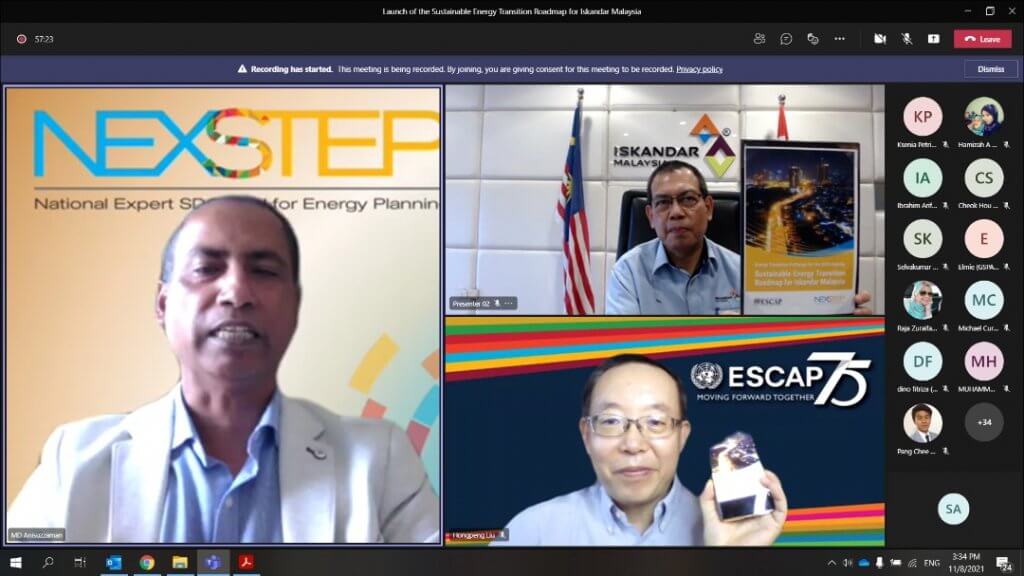
SPEECH TEXT
YBhg. Datuk Ismail Ibrahim
Chief Executive, IRDA
LAUNCH OF SUSTAINABLE ENERGY TRANSITION ROADMAP FOR ISKANDAR MALAYSIA
11th Oct 2021 | 2:30 p.m.
_____________________
Dr. Rashed Mustafa Sarwar,
Representative to Malaysia and Special Representative to Brunei Darussalam, UNICEF, and Resident Coordinator;
Mr. Hongpeng Liu,
The Director of Energy Division, UN ESCAP;
Distinguished Panelists;
Ladies and gentlemen,
Assalamualaikum w.b.t. and a very good afternoon to all.
I would like to start by thanking UN HABITAT, UN ESCAP and all our partners for your support and presence at the launch of “Sustainable Energy Transition Roadmap for Iskandar Malaysia” today.
I am happy also that this roadmap materialises right in time for the 15th year anniversary of Iskandar Malaysia this year.
Iskandar Malaysia covers a total area of 2,217 sq km, an area 3 times bigger than Singapore. Economically, up until April 2021, Iskandar Malaysia has successfully achieved a total cumulative investment of USD75 billion mainly through its 9 promoted economic sectors such as Electrical & Electronics, Petroleum and Oleo-Chemical and Logistics.
These are vital to Iskandar Malaysia in achieving its vision to be a strong and sustainable metropolis of international standing and will require a lot of reliable and affordable energy, especially in manufacturing and transportation.
Without any sustainable intervention, it is forecasted that by 2025, the energy required can reach up to 3838MW (Megawatt). This might lead to insufficient reliable energy and the misuse of energy sources in order to cater for the need thus causing an imbalance between the input and output.
In light of this, the “Sustainable Energy Transition Roadmap for Iskandar Malaysia” has been developed to identify technological options and policy measures that will help the economic region navigate the transition of its energy sector in line with the 2030 Agenda for Sustainable Development as well as achieving goals and targets in economic, social and environmental aspects.
Ladies & gentlemen,
Iskandar Malaysia’s renewable energy and energy efficiency vision is to ensure sustainable and livable development in the region by implementing efficient energy management and incorporating renewable energy to develop a diverse low-carbon energy mix and achieve energy demand reduction.
We are aware of the need to develop economies that do not only rely on fossil fuel, but sources of power should also come from renewable resources.
As mentioned earlier, Iskandar Malaysia has a strong industry sector, which contributes around 44 per cent of its GDP.
To assist our energy direction in industry sectors, we have sets of documents to support the energy management and implementation of green agenda in Iskandar Malaysia such as of Green Economy Guideline for industries and promoting industry sectors to practice energy audit with measured recommendations.
Additionally, the potential in establishing industrial symbiosis within the industrial clusters should be explored. Industrial symbiosis can be described as a process that allows material or energy sharing between production facilities, where the unwanted material from one facility becomes a raw material for the other. This promotes a more sustainable industry based on circular economy.
Iskandar Malaysia is also collaborating with partners such as the solar service providers to roles to promote, plan and facilitate suitable renewable energy projects in the region. We have also integrated the renewable energy plan in our physical projects such as Iskandar Malaysia Bus Rapid Transit (IMBRT), Sg Segget Landscaping and Beautification Project and Kawan Iskandar Malaysia.
As an example, IMBRT is expected to provide multi-fold benefits. Primarily, energy consumption in the transport sector is projected to decrease and consequently, the reduced fuel combustion from the transport sector allows an estimated 35 per cent reduction compared to the BAU scenario.
IMBRT is also meant to reduce traffic congestion – a major problem in cities. With the population expected to grow at a rate of 4 per cent annually, traffic congestion is likely to worsen without intervention. Additionally, air pollution can be substantially decreased by taking cars off the road. Such initiatives pave the way for a more liveable city.
The end game will be the reduction of greenhouse gas emissions. According to the Green House Gases (GHG) Inventory for Iskandar Malaysia, emission intensity per GDP in the year 2017 was reduced by about 12.9% compared to 2010 emission intensity as the baseline.
Such decrease in emission intensity is a positive sign despite the continuous growth of the region, and we believe that Iskandar Malaysia could achieve the target of emission intensity reduction of 58% of base year (2010) emissions by 2025
Ladies & gentlemen,
The “Sustainable Energy Transition Roadmap for Iskandar Malaysia” is a collaboration between IRDA, UN ESCAP and other partners from various international, federal and state agencies, and the private sectors.
We believe that through this collaboration and partnership, the roadmap can be made a reality supported by ample resources to implement capacity building, awareness programs as well as research and development.
Finally, I hope that everyone will benefit from the presentation and panellist session afterwards.
I would like to thank UN Habitat and UN ESCAP and all our partners again for your support and presence and with that, I wish everyone the best of luck with the “Sustainable Energy Transition Roadmap for Iskandar Malaysia”.
Thank you.






